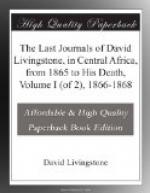19th December, 1866.—I got a fine male kudu. We have no grain, and live on meat alone, but I am better off than the men, inasmuch as I get a little goat’s-milk besides. The kudu stood five feet six inches high; horns, three feet on the straight.
20th December, 1866.—Reached Casembe,[40] a miserable hamlet of a few huts. The people here are very suspicious, and will do nothing but with a haggle for prepayment; we could get no grain, nor even native herbs, though we rested a day to try.
After a short march we came to the Nyamazi, another considerable rivulet coming from the north to fall into the Loangwa. It has the same character, of steep alluvial banks, as Pamazi, and about the same width, but much shallower; loin deep, though somewhat swollen; from fifty to sixty yards wide. We came to some low hills, of coarse sandstone, and on crossing these we could see, by looking back, that for many days we had been travelling over a perfectly level valley, clothed with a mantle of forest. The barometers had shown no difference of level from about 1800 feet above the sea. We began our descent into this great valley when we left the source of the Bua; and now these low hills, called Ngale or Ngaloa, though only 100 feet or so above the level we had left, showed that we had come to the shore of an ancient lake, which probably was let off when the rent of Kebra-basa on the Zambesi was made, for we found immense banks of well-rounded shingle above—or, rather, they may be called mounds of shingle—all of hard silicious schist with a few pieces of fossil-wood among them. The gullies reveal a stratum of this well-rounded shingle, lying on a soft greenish sandstone, which again lies on the coarse sandstone first observed. This formation is identical with that observed formerly below the Victoria Falls. We have the mountains still on our north and north-west (the so-called mountains of Bisa, or Babisa), and from them the Nyamazi flows, while Pamazi comes round the end, or what appears to be the end, of the higher portion. (22nd December, 1866.) Shot a bush-buck; and slept on the left bank of Nyamazi.
23rd December, 1866.—Hunger sent us on; for a meat diet is far from satisfying: we all felt very weak on it, and soon tired on a march, but to-day we hurried on to Kavimba, who successfully beat off the Mazitu. It is very hot, and between three and four hours is a good day’s march. On sitting down to rest before entering the village we were observed, and all the force of the village issued to kill us as Mazitu, but when we stood up the mistake was readily perceived, and the arrows were placed again in their quivers. In the hut four Mazitu shields show that they did not get it all their own way; they are miserable imitations of Zulu shields, made of eland and water-buck’s hides, and ill sewn.




